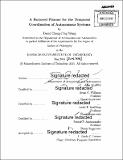| dc.contributor.advisor | Supervised byBrian C. Williams, Leslie P. Kaelbling and Saman P. Amarasinghe. | en_US |
| dc.contributor.author | Wang, David Cheng-Ping | en_US |
| dc.contributor.other | Massachusetts Institute of Technology. Department of Aeronautics and Astronautics. | en_US |
| dc.date.accessioned | 2015-09-17T19:13:27Z | |
| dc.date.available | 2015-09-17T19:13:27Z | |
| dc.date.copyright | 2015 | en_US |
| dc.date.issued | 2015 | en_US |
| dc.identifier.uri | http://hdl.handle.net/1721.1/98806 | |
| dc.description | Thesis: Ph. D., Massachusetts Institute of Technology, Department of Aeronautics and Astronautics, 2015. | en_US |
| dc.description | Cataloged from PDF version of thesis. | en_US |
| dc.description | Includes bibliographical references (pages 127-131). | en_US |
| dc.description.abstract | Embedded devices are being composed into ever more complex networked systems, including Earth observing systems and transportation networks. The complexity of these systems require automated coordination, but planning for and controlling these systems pose unique challenges. Devices can exhibit stateful, timed, and periodic behavior. A washing machine transitions automatically between its wash cycles while locking its door accordingly. The interaction between devices can cause indirect effects and require concurrency. A UAV with a simple GPS-based auto pilot may refuse to take off until it has a GPS fix, and may further require that fix be maintained while flying its route. While many planners exist that support some of these features, to our knowledge, no planner can support them all, and none can handle automatic timed transitions. In this thesis, we present tBurton, a domain-independent temporal planner for complex networked systems. tBurton can generate a plan that meets deadlines and maintains durative goals. Furthermore, the plan it generates is temporally least-commitment, affording some flexibility during plan execution. tBurton uses a divide and conquer approach: dividing the problem into a directed acyclic graph of factors via causal-graph decomposition and conquering each factor with heuristic forward search. Planning is guided by the DAG structure of the causal graph, and consists of a recursive element. All of the sub-goals for a particular factor are gathered before generating its plan and regressing its sub-goals to parent factors. Key to this approach is a process we call unification, which exploits the locality of information afforded by factoring to efficiently prune unachievable sub-goal orderings before the computationally expensive task of planning. The contributions of this thesis are three fold: First, we introduce a planner for networked devices that supports a set of features never before found in one planner. Second, we introduce a new approach to factored planning based on timeline-based regression and heuristic forward search. Third, we demonstrate the effectiveness of this approach on both existing planning benchmarks, as well as a set of newly developed benchmarks that model networked devices. | en_US |
| dc.description.statementofresponsibility | by David Cheng-Ping Wang. | en_US |
| dc.format.extent | 131 pages | en_US |
| dc.language.iso | eng | en_US |
| dc.publisher | Massachusetts Institute of Technology | en_US |
| dc.rights | M.I.T. theses are protected by copyright. They may be viewed from this source for any purpose, but reproduction or distribution in any format is prohibited without written permission. See provided URL for inquiries about permission. | en_US |
| dc.rights.uri | http://dspace.mit.edu/handle/1721.1/7582 | en_US |
| dc.subject | Aeronautics and Astronautics. | en_US |
| dc.title | A factored planner for the temporal coordination of autonomous systems | en_US |
| dc.type | Thesis | en_US |
| dc.description.degree | Ph. D. | en_US |
| dc.contributor.department | Massachusetts Institute of Technology. Department of Aeronautics and Astronautics | |
| dc.identifier.oclc | 921146944 | en_US |
